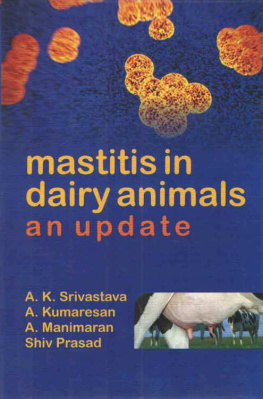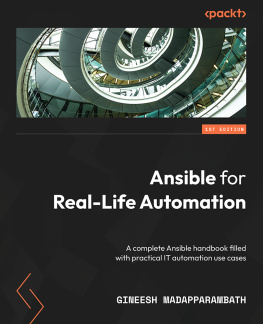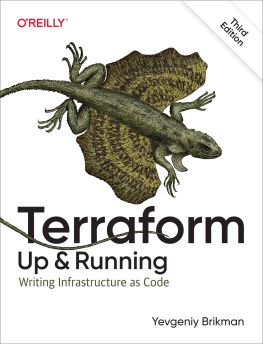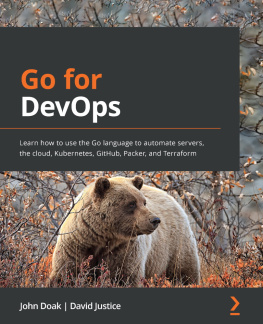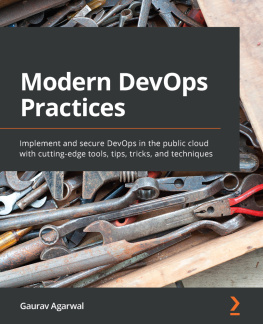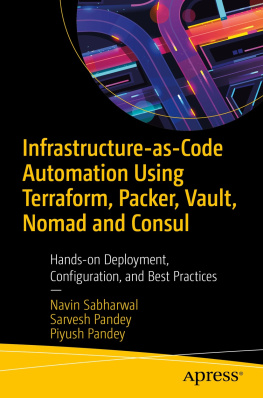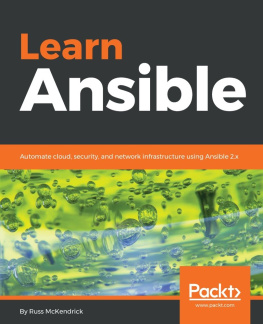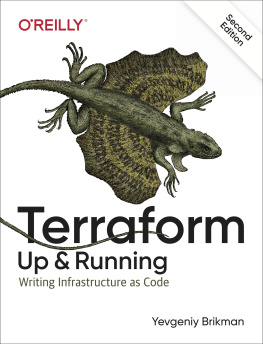Srivastava - DevOps in SharePoint: Hands-On Packer, Terraform, Ansible, Vagrant
Here you can read online Srivastava - DevOps in SharePoint: Hands-On Packer, Terraform, Ansible, Vagrant full text of the book (entire story) in english for free. Download pdf and epub, get meaning, cover and reviews about this ebook. year: 2021, publisher: UNKNOWN, genre: Romance novel. Description of the work, (preface) as well as reviews are available. Best literature library LitArk.com created for fans of good reading and offers a wide selection of genres:
Romance novel
Science fiction
Adventure
Detective
Science
History
Home and family
Prose
Art
Politics
Computer
Non-fiction
Religion
Business
Children
Humor
Choose a favorite category and find really read worthwhile books. Enjoy immersion in the world of imagination, feel the emotions of the characters or learn something new for yourself, make an fascinating discovery.

- Book:DevOps in SharePoint: Hands-On Packer, Terraform, Ansible, Vagrant
- Author:
- Publisher:UNKNOWN
- Genre:
- Year:2021
- Rating:3 / 5
- Favourites:Add to favourites
- Your mark:
- 60
- 1
- 2
- 3
- 4
- 5
DevOps in SharePoint: Hands-On Packer, Terraform, Ansible, Vagrant: summary, description and annotation
We offer to read an annotation, description, summary or preface (depends on what the author of the book "DevOps in SharePoint: Hands-On Packer, Terraform, Ansible, Vagrant" wrote himself). If you haven't found the necessary information about the book — write in the comments, we will try to find it.
DevOps in SharePoint: Hands-On Packer, Terraform, Ansible, Vagrant — read online for free the complete book (whole text) full work
Below is the text of the book, divided by pages. System saving the place of the last page read, allows you to conveniently read the book "DevOps in SharePoint: Hands-On Packer, Terraform, Ansible, Vagrant" online for free, without having to search again every time where you left off. Put a bookmark, and you can go to the page where you finished reading at any time.
Font size:
Interval:
Bookmark:
DevOps in SharePoint
Copyright 2021 by Sachin Srivastava
This work is subject to copyright. All rights are reserved by the Author, whether the whole or part of the material is concerned, specifically the rights of translation, reprinting, reuse of illustrations, recitation, broadcasting, reproduction on microfilms or in any other physical way, and transmission or information storage and retrieval, electronic adaptation, computer software, or by similar or dissimilar methodology now known or hereafter developed.
Trademarked names, logos, and images may appear in this book. Rather than use a trademark symbol with every occurrence of a trademarked name, logo, or image we use the names, logos, and images only in an editorial fashion and to the benefit of the trademark owner, with no intention of infringement of the trademark.
The use in this publication of trade names, trademarks, service marks, and similar terms, even if they are not identified as such, is not to be taken as an expression of opinion as to whether or not they are subject to proprietary rights.
While the advice and information in this book are believed to be true and accurate at the date of publication, neither the author nor the publisher can accept any legal responsibility for any errors or omissions that may be made. The author makes no warranty, express or implied, with respect to the material contained herein.
Printed on acid-free paper v
v vi
vi vii
vii viii
viii Sachin Srivastava is a solutions architect and cloud consultant with over 15 years in the technology sector. Sachins experience dates back to the dot-com boom era, where he managed ecommerce sites based on Unix and written in Java. He is an advocate for DevOps practices with a focus on cloud-agnostic tools and modern frameworks. Sachins software development, coupled with cloud infrastructure, has been instrumental in helping companies realize the benefits of many clouds by mentoring teams in migrating legacy monolithic applications into microservices, building CI/CD

pipelines, and orchestrating Docker containers using Kubernetes on three of the leading clouds (AWS, GCP, and Azure), all while maintaining a cloud-agnostic strategy.
Vikas Singh is a solutions architect. In his role he discovered a passion for automating Windows using Ansible. He has twice spoken at AnsibleFest California about Ansibles Windows support. He has contributed several Ansible Windows modules, and he has been an external core committer to the Ansible project since 2016. He can be found helping others automate on the #ansible IRC channel or on the Ansible-- project Google group.
Id like to thank two wonderful people that supported me on this journey. First, my parents, for all of their enthusiasm and dedication. They made this project so
much easier, and I am forever grateful for this.
Id also like to thank my good friend Vikas Singh. Vikas, I value your friendship and
appreciate all the work you put into our project. Your support means so much to me. Thank
you for being such a great soul.
In this chapter, we discuss DevOps. We put it into context as it relates to SharePoint infrastructure projects, and how we can leverage these practices and tools to ultimately achieve agility, predictability, repeatability in deployments, and cost savings in the maintenance aspect of the platform on-premises or in the cloud.
Note This book focuses on DevOps as it relates to the infrastructure of SharePoint; however, these principles apply to the development of new features on top of SharePoint (i.e., WebParts, workflows, or new components using the SharePoint Framework).
DevOps is comprised of principles (both technical and cultural) and practices for delivering applications and services at high velocity. In many organizations, these practices entail that the development and IT pros/operations teams work together in the full life cycle to achieve this. This is where the cultural aspect of DevOps practice comes into play, as it represents a shift from the traditional silos of these teams; however, the collaboration between these teams is paramount to increase DevOps maturity within the enterprise.
This collaboration between the two teams increases agility and transparency in delivering the solutions that ultimately both teams are responsible for. With this transparency, product managers and other internal customers can easily gain insight into any progress and/or problems in the delivery pipeline.
Figure 1-1 shows you where three common siloed enterprise teams efforts are joined to practice DevOps. Figure 1-1. Three traditionally siloed enterprise teams are joined to practice DevOps within the enterprise
Figure 1-1. Three traditionally siloed enterprise teams are joined to practice DevOps within the enterpriseDepending on the size of an organization, there could be fewer teams; for example, an organization may have a development team that writes their own automation tests, and an operations team whose focus is on infrastructure on-premises or in the cloud.
Lets take a closer look at the core practices of DevOps to further help us understand why DevOps is important as it relates to SharePoint initiatives.In the scenario shown in Figure 1-2 , there are two teams. The development teams focus as it relates to applying the core DevOps practices typically involves code build, test coverage, packaging, and deployment readiness. For the operations team, however, most of the focus is onenabling the automation of the development teams tests and builds, as well as the infrastructure, which includes provisioning, configuration management, orchestration and deployment of software, and infrastructure using IaC (Infrastructure as Code).
Note We go over IaC in the Applying DevOps Practices section of this chapter. Figure 1-2. The development and operations teams collaborate to practice DevOps
Figure 1-2. The development and operations teams collaborate to practice DevOpsIt is important to note that the same underlying methods, such as version control, rollback, and testing are used by both teams while applying DevOps practices. Figure 1-3 is a holistic DevOps view that shows the various componentssuch
Font size:
Interval:
Bookmark:
Similar books «DevOps in SharePoint: Hands-On Packer, Terraform, Ansible, Vagrant»
Look at similar books to DevOps in SharePoint: Hands-On Packer, Terraform, Ansible, Vagrant. We have selected literature similar in name and meaning in the hope of providing readers with more options to find new, interesting, not yet read works.
Discussion, reviews of the book DevOps in SharePoint: Hands-On Packer, Terraform, Ansible, Vagrant and just readers' own opinions. Leave your comments, write what you think about the work, its meaning or the main characters. Specify what exactly you liked and what you didn't like, and why you think so.

